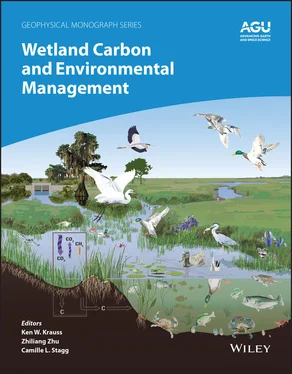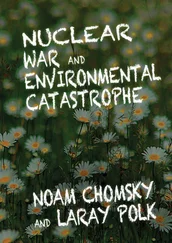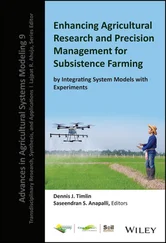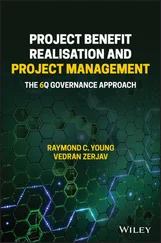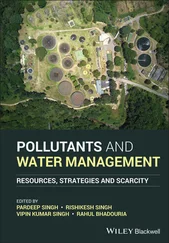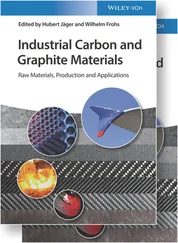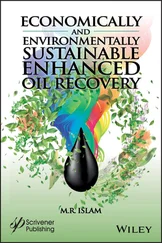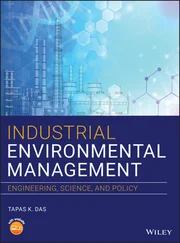308 Mulholland, P. J., & Kuenzler, E. J. (1979). Organic carbon export from upland and forested wetland watersheds. Limnology and Oceanography, 24(5), 960–966. https://doi.org/10.4319/lo.1979.24.5.0960
309 Mwamba, M. J., & Torres, R. (2002). Rainfall effects on marsh sediment redistribution, North Inlet, South Carolina, USA. Marine Geology, 189(3–4), 267–287. https://doi.org/10.1016/S0025‐3227(02)00482‐6
310 Myhre, G., Shindell, D., Bréon, F.‐M., Collins, W., Fuglestvedt, J. S., Huang, J., et al. (2013). Anthropogenic and natural radiative forcing. In: T. F. Stocker, D. Qin, G.‐K. Plattner, M. Tignor, S. K. Allen, J. Boschung, et al. (Eds.), Climate Change 2013: The Physical Science Basis. Contribution of Working Group I to the Fifth Assessment Report of the Intergovernmental Panel on Climate Change (pp. 659–740). Cambridge, United Kingdom and New York, NY, USA: Cambridge University Press.
311 Myneni, S. C. B., Brown, J. T., Martinez, G. A., & Meyer‐Ilse, W. (1999). Imaging of humic substance macromolecular structures in water and soils. Science, 286(5443), 1335–1337. https://doi.org/10.1126/science.286.5443.1335
312 Nag, S. K., Nandy, S. K., Roy, K., Sarkar, U. K., & Das, B. K. (2019). Carbon balance of a sewage‐fed aquaculture wetland. Wetlands Ecology and Management, 27(2–3), 311–322. https://doi.org/10.1007/s11273‐019‐09661‐8
313 Needelman, B. A., Emmer, I. M., Oreska, M. P. J., & Megonigal, J. P. (2018). Blue carbon accounting for carbon markets. In: L.‐M. Windham‐Myers, S. Crooks, & T. Troxler‐Gann (Eds.), A Blue Carbon Primer: The State of Coastal Wetland Carbon Science, Practice, and Policy (pp. 283–292). Boca Raton, FL: CRC Press.
314 Needelman, B. A., Emmer, I. M., Emmett‐Mattox, S., Crooks, S., Megonigal, J. P., Myers, D., et al. (2018). The science and policy of the Verified Carbon Standard methodology for tidal wetland and seagrass restoration. Estuaries and Coasts, 41(8), 2159–2171. https://doi.org/10.1007/s12237‐018‐0429‐0
315 Neely, R. K., & Davis, C. B. (1985). Nitrogen and phosphorus fertilization of Sparganium eurycarpum Engelm. and Typha glauca Godr. stands. I. Emergent plant production. Aquatic Botany, 22(3–4), 347–361. https://doi.org/10.1016/0304‐3770(85)90009‐9
316 Nelson, P. N., Dictor, M. C., & Soulas, G. (1994). Availability of organic carbon in soluble and particle‐size fractions from a soil profile. Soil Biology and Biochemistry, 26(11), 1549–1555. https://doi.org/10.1016/0038‐0717(94)90097‐3
317 Neubauer, S. C. (2013). Ecosystem responses of a tidal freshwater marsh experiencing saltwater intrusion and altered hydrology. Estuaries and Coasts, 36(3), 491–507. https://doi.org/10.1007/s12237‐011‐9455‐x
318 Neubauer, S. C., & Anderson, I. C. (2003). Transport of dissolved inorganic carbon from a tidal freshwater marsh to the York River estuary. Limnology and Oceanography, 48(1), 299–307. https://doi.org/10.4319/lo.2003.48.1.0299
319 Neubauer, S. C., & Megonigal, J. P. (2015). Moving beyond global warming potentials to quantify the climatic role of ecosystems. Ecosystems, 18(6), 1000–1013. https://doi.org/10.1007/s10021‐015‐9879‐4
320 Neubauer, S. C., & Verhoeven, J. T. A. (2019). Wetland effects on global climate: Mechanisms, impacts, and management recommendations. In: S. An & J. T. A. Verhoeven (Eds.), Wetlands: Ecosystem Services, Restoration and Wise Use, Ecological Studies 238 (pp. 39–62). Springer Nature. https://doi.org/10.1007/978‐3‐030‐14861‐4_3
321 Neubauer, S. C., Miller, W. D., & Anderson, I. C. (2000). Carbon cycling in a tidal freshwater marsh ecosystem: A carbon gas flux study. Marine Ecology Progress Series, 199, 13–30. https://doi.org/10.3354/meps199013
322 Neubauer, S. C., Anderson, I. C., Constantine, J. A., & Kuehl, S. A. (2002). Sediment deposition and accretion in a mid‐Atlantic (U.S.A.) tidal freshwater marsh. Estuarine, Coastal and Shelf Science, 54(4), 713–727. https://doi.org/10.1006/ecss.2001.0854
323 Neubauer, S. C., Anderson, I. C., & Neikirk, B. B. (2005). Nitrogen cycling and ecosystem exchanges in a Virginia tidal freshwater marsh. Estuaries, 28(6), 909–922. https://doi.org/10.1007/BF02696019
324 Neubauer, S. C., Givler, K., Valentine, S., & Megonigal, J. P. (2005). Seasonal patterns and plant‐mediated controls of subsurface wetland biogeochemistry. Ecology, 86(12), 3334–3344. https://doi.org/10.1890/04‐1951
325 Neubauer, S. C., Franklin, R. B., & Berrier, D. J. (2013). Saltwater intrusion into tidal freshwater marshes alters the biogeochemical processing of organic carbon. Biogeosciences, 10(12), 8171–8183. https://doi.org/10.5194/bg‐10‐8171‐2013
326 Niu, Z., Zhang, H., Wang, X., Yao, W., Zhou, D., Zhao, K., et al. (2012). Mapping wetland changes in China between 1978 and 2008. Chinese Science Bulletin, 57(22), 2813–2823. https://doi.org/10.1007/s11434‐012‐5093‐3
327 De Nobili, M., Bravo, C., & Chen, Y. (2020). The spontaneous secondary synthesis of soil organic matter components: A critical examination of the soil continuum model theory. Applied Soil Ecology, 154(January), 103655. https://doi.org/10.1016/j.apsoil.2020.103655
328 O’Connor, J. J., Fest, B. J., Sievers, M., & Swearer, S. E. (2020). Impacts of land management practices on blue carbon stocks and greenhouse gas fluxes in coastal ecosystems—A meta‐analysis. Global Change Biology, 26(3), 1354–1366. https://doi.org/10.1111/gcb.14946
329 Odum, W. E., Odum, E. P., & Odum, H. T. (1995). Nature’s pulsing paradigm. Estuaries, 18(4), 547–555. https://doi.org/10.2307/1352375
330 Olivares, C. I., Zhang, W., Uzun, H., Erdem, C. U., Majidzadeh, H., Trettin, C. C., et al. (2019). Optical in‐situ sensors capture dissolved organic carbon (DOC) dynamics after prescribed fire in high‐DOC forest watersheds. International Journal of Wildland Fire, 28(10), 761–768. https://doi.org/10.1071/WF18175
331 Oremland, R. S., Marsh, L. M., & Polcin, S. (1982). Methane production and simultaneous sulphate reduction in anoxic, salt marsh sediments. Nature, 296(March), 143–145. https://doi.org/10.1038/296143a0
332 Padgett, D. E., & Celio, D. A. (1990). A newly discovered role for aerobic fungi in anaerobic salt marsh soils. Mycologia, 82(6), 791. https://doi.org/10.2307/3760170
333 Paerl, H. W., Pinckney, J. L., Fear, J. M., & Peierls, B. L. (1998). Ecosystem responses to internal and watershed organic matter loading: Consequences for hypoxia in the eutrophying Neuse River Estuary. Marine Ecology Progress Series, 166, 17–25. https://doi.org/10.3354/meps166017
334 Paerl, H. W., Crosswell, J. R., Van Dam, B., Hall, N. S., Rossignol, K. L., Osburn, C. L., et al. (2018). Two decades of tropical cyclone impacts on North Carolina’s estuarine carbon, nutrient and phytoplankton dynamics: Implications for biogeochemical cycling and water quality in a stormier world. Biogeochemistry, 141(3), 307–332. https://doi.org/10.1007/s10533‐018‐0438‐x
335 Page, S. E., Siegert, F., Rieley, J. O., Boehm, H. D. V., Jaya, A., & Limin, S. (2002). The amount of carbon released from peat and forest fires in Indonesia during 1997. Nature, 420(6911), 61–65. https://doi.org/10.1038/nature01131
336 Page, S. E., Hosciło, A., Wösten, H., Jauhiainen, J., Silvius, M., Rieley, J., et al. (2009). Restoration ecology of lowland tropical peatlands in Southeast Asia: Current knowledge and future research directions. Ecosystems, 12(6), 888–905. https://doi.org/10.1007/s10021‐008‐9216‐2
337 Pangala, S. R., Enrich‐Prast, A., Basso, L. S., Peixoto, R. B., Bastviken, D., Hornibrook, E. R. C., et al. (2017). Large emissions from floodplain trees close the Amazon methane budget. Nature, 552(7684), 230–234. https://doi.org/10.1038/nature24639
338 De Paolis, F., & Kukkonen, J. (1997). Binding of organic pollutants to humic and fulvic acids: Influence of pH and the structure of humic material. Chemosphere, 34(8), 1693–1704. https://doi.org/10.1016/S0045‐6535(97)00026‐X
Читать дальше
